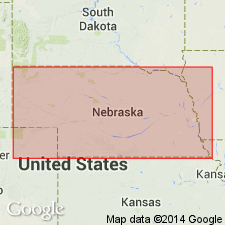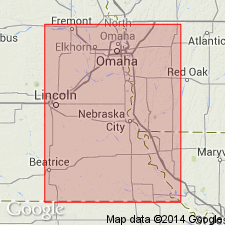
- Usage in publication:
-
- Union limestone member
- Modifications:
-
- Original reference
- Dominant lithology:
-
- Limestone
- AAPG geologic province:
-
- Nemaha anticline
Summary:
Pg. 7, 13, 37. Union limestone member of Braddyville formation. Separated from underlying Meadow limestone by 5 to 6 feet of shale, and overlain by a series of interbedded shales and limestones. Thickness 1 foot 8 inches to 8 feet. Exposed in old quarry at Union, Cass Co., southeastern NE, in NW/4 sec. 22, T. 10 N., R. 13 E.; also 1.5 mi southwest of Union, along South Branch of the Weeping Water, in secs. 33 and 28, T. 10 N., R. 13 E., southeastern NE. In section at Jones Point consists of (descending): limestone, 1 foot; carbonaceous shale, 1 foot 2 inches; blue limestone, 8 inches; bluish limestone in 5 distinct beds, 4 feet; shale, 1 inch; brittle limestone that weathers rusty, 1 foot 3 inches. Fossiliferous (lamellibranchs, brachiopods, crinoid stems, gastropods, mollusk PINNA, and bryozoan RHOMBOPORA LEPIDODENDROIDES). Age is Pennsylvanian. Report includes measured sections, cross sections.
Named from Union, Cass Co., southeastern NE.
Source: US geologic names lexicon (USGS Bull. 896, p. 2215-2216); GNC KS-NE Pennsylvanian Corr. Chart, sheet 1, Oct. 1936; supplemental information from GNU records (USGS DDS-6; Denver GNULEX).

- Usage in publication:
-
- Union limestone†
- Modifications:
-
- Abandoned
Summary:
Pg. 52, 53. Upper unit of Topeka limestone was named Union limestone by Condra and Bengston. This name being preoccupied the division is here named Coal Creek limestone, from exposures on Coal Creek, north of Union, Nebraska. The limestone is dark blue, dense, brittle, and very fossiliferous. At places it is split in 2 or 3 beds. Overlies Holt shale. The Meadow limestone belongs down in Calhoun shale member.
Source: US geologic names lexicon (USGS Bull. 896, p. 2215-2216).
For more information, please contact Nancy Stamm, Geologic Names Committee Secretary.
Asterisk (*) indicates published by U.S. Geological Survey authors.
"No current usage" (†) implies that a name has been abandoned or has fallen into disuse. Former usage and, if known, replacement name given in parentheses ( ).
Slash (/) indicates name conflicts with nomenclatural guidelines (CSN, 1933; ACSN, 1961, 1970; NACSN, 1983, 2005, 2021). May be explained within brackets ([ ]).

